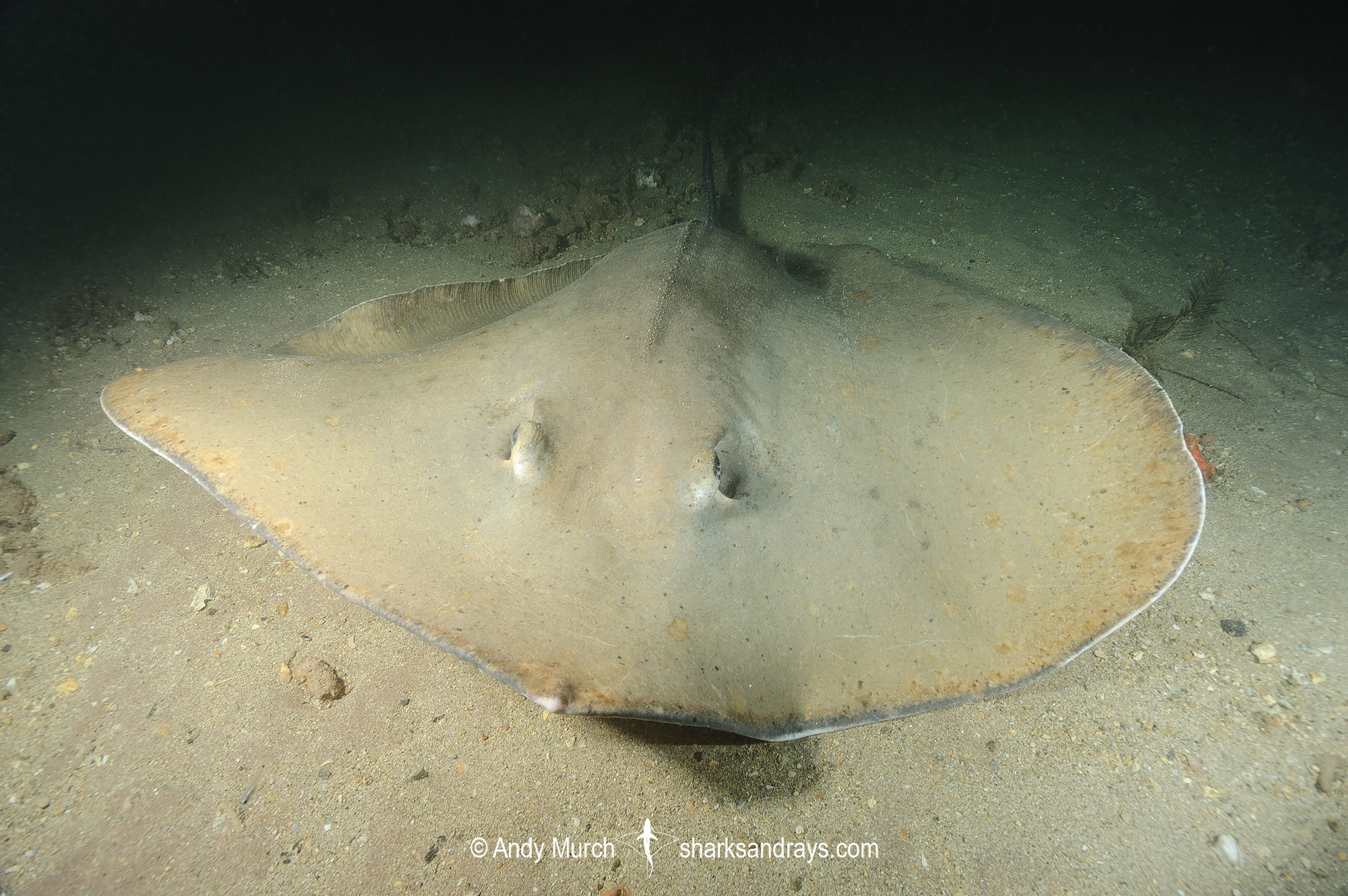Common name(s)
Jenkins’ Whipray.
Identification
A large stingray with a kite-shaped disc that is wider than long; disc width approximately 1.1 x length. Snout fairly short, and obtusely angular. Apical lobe (snout tip) triangular, slightly extended. Anterior margins of disc straight. Pectoral fin apices narrowly rounded.
Eyes small and slightly protruding. Snout length 2-2.5 x combined eye and spiracle length. Mouth small to medium-sized, containing 2-4 oral papillae; 2 central papillae very large, lateral papillae very small. Prominent labial furrows and folds around mouth. Lower jaw slightly arched. Nasal curtain skirt-shaped; posterior margin finely fringed.
A thin but prominent, dense denticle band on mid-shoulder. Row of pronounced wedge-shaped thorns along midline. Tail short, narrow based, sub-circular in cross-section. Tail tapers gently to caudal sting, then whip-like to tip. Tail length (when intact) 1.1-1.4 x disc width. Caudal finfolds absent. 1-3 caudal stings may be present.
Colour
Dorsum yellow-brown; slightly lighter patches in front of eyes. Ventrum white. Tail beyond caudal sting fades to black.
Size
Maximum disc width 150cm. Disc width at birth approximately 23cm.
Habitat
Tropical seas. On sandy substrates, often adjacent to reefs. From shallow bays to at least 90m on continental shelf; usually less than 50m.
Distribution
Indian Ocean and western Pacific. Recorded from South Africa and East Africa but unconfirmed around the Horn of Africa or in the Red Sea. Present in the Arabian Gulf to India, throughout Southeast Asia, and in northern Australia.
Conservation Status
VULNERABLE
Jenkins’ Whipray (Pateobatis jenkinsii) is taken as a utilised bycatch of tangle net, gillnet, trawl net, and dropline fisheries throughout Southeast Asia and parts of the Indian Ocean where inshore fishing pressure is intense. It is caught in particularly high numbers in the target fishery for rhynchobatids operating in the Arafura Sea. Levels of exploitation are very high throughout its range in Southeast Asia and in many parts of the Indian Ocean, hence it is under a severe level of threat within most of this range. Although no species-specific data are available, overall catches of stingrays are reported to be declining in areas of Southeast Asia for which information is available, with fishermen having to travel further and further to sustain catch levels. The species is highly sought after in Southeast Asia for the high value of its skin. Little is known of the subpopulation off southeastern Africa, although the species is probably taken as bycatch of shrimp trawlers there. Fisheries in northern Australia are generally well managed and the introduction of turtle exclusion devices (TEDs) has significantly reduced the bycatch of large stingrays. In Australia, Jenkins’ Whipray is considered at minimal threat throughout its wide range as there is no information to suggest that this species has declined in this area.
This large species may have limiting life history characteristics that make it biologically susceptible to depletion in fisheries and therefore, efforts should be made to assess and monitor mortality in fisheries and population trends throughout its range. Given the continuation of high levels of exploitation throughout its range in Southeast Asia where the species is caught in multiple types of fisheries, along with evidence for declines in catches of rays, the level of decline (>30% over the last three generations) and exploitation can be inferred from overall declines in fish catches in the region, as well as from habitat loss. Jenkins’ Whipray is assessed as Vulnerable globally based on inferred levels of decline and exploitation across a large part of its range, but is considered to be Least Concern in Australia.
Citation
Manjaji Matsumoto, B.M., Fahmi & White, W.T. 2020. Pateobatis jenkinsii (amended version of 2016 assessment). The IUCN Red List of Threatened Species 2020: e.T161744A176850023. https://dx.doi.org/10.2305/IUCN.UK.2020-3.RLTS.T161744A176850023.en. Downloaded on 24 February 2021.
Reproduction
Histotrophic viviparity. Litter size unknown.
Diet
Diet unknown but presumably feeds on small fishes and prawns like its close cousin the pink whipray.
Behavior
Known to shelter in caves and under reef ledges.
Reaction to divers
Shy unless accustomed to divers. Then, fairly nonchalant unless approached too closely.
Diving logistics
Jenkins’ whiprays are seen quite regularly at Ningaloo Reef and around the Navy Pier in Exmouth, Western Australia.





